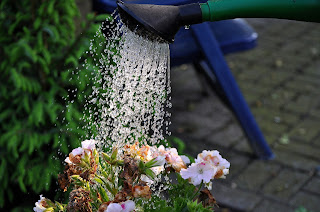How to Maintain a Water-Friendly Garden
To water one square foot of lawn to the depth on one inch takes a little over half a gallon. Multiply that by the square footage of your lawn, and you may discover that you are using thousands of gallons of fresh, potable water every summer.
There’s a better way. It’s called xeriscaping—derived from the Greek word “xeros”, meaning hard. But there’s nothing difficult about xeriscaping, the best technique for ensuring an attractive lawn and garden with minimal water usage. This environmentally-friendly way to landscape starts with selecting plants that thrive under harsher conditions and, once established, require no additional water.
Choose Native Virginia and Drought-Tolerant Plants
First, go native. Plants that were here long before suburbs and back yards have adapted to the Central Virginia climate of punishing summers interspersed with intense storms. In fact, once established, many are perfectly happy without watering. Check out publications of the Virginia Department of Conservation and Recreation and the Virginia Native Plant Society for possible candidates.
Second, choose drought tolerant plants that have adapted to tough conditions and soils that do not hold water. Don’t limit yourself to the yucky yucca, albeit a Virginia native. Many attractive and bee- and butterfly-friendly shrubs, such as Virginia Sweetspire (also a native), Cotoneaster, and Lantana are surprisingly hardy. Hawthorns, Shagbark Hickories, and Crape Myrtles are reliable year in, year out. Ice plants and Candytuft, VInca, and Bugleweed spread nicely and take the heat like champs.
 Group Plants According to Watering Needs
Group Plants According to Watering Needs
Another trick is to mass plants according to how much water they need so that you don’t have to water the whole garden just to quench the thirst of the few that require regular watering. And, if you simply can’t do without a lawn, seed with drought-tolerant turf that will grow in our hard clay. Once established, centipede, bahia, Bermuda, and zoysia grasses do very well with minimal water. During droughts, they become dormant but, when it rains, they quickly turn green again.
 Minimize Evaporation with Layered Mulch
Minimize Evaporation with Layered Mulch
When all is said and done, the easiest way to conserve water is to minimize evaporation. That means mulch and more mulch. Start by spreading newspapers or paper grocery bags on the areas between and around plants that you want to cover. (Worms thrive on this paper layer, and their “poop” provides an extra nutrient boost to your plants.) Cover the paper layer with a thick—minimum 3 inches—layer of wood chips or dried grass clippings. You’ll save a lot of weeding time; your garden will benefit from better soil next year; and you’re saving water, the planet’s most important (and threatened) resource.





